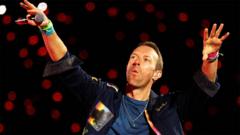Coldplay and Ed Sheeran are among a wave of international musicians performing in India, catering to an expanding audience eager for live shows.
Historically, Indian music enthusiasts expressed disappointment over missed opportunities to see their favorite artists live. Yet, this trend appears to be evolving as international acts like Dua Lipa have successfully performed in major cities, setting the stage for Coldplay’s highly anticipated return after nine years. The band is expected to attract over 100,000 fans to each of their shows in Ahmedabad.
India’s burgeoning demand for live music is reflected in ticket sales, with platforms like BookMyShow reporting an 18% growth for 2024. Ed Sheeran's upcoming tour aims to make a splash, and prominent artists such as Shawn Mendes and Louis Tomlinson are scheduled for performances at the Lollapalooza festival in March, showcasing India's expanding musical landscape.
Marketing expert Dr. Sourindra Banerjee emphasizes the significance of India’s youthful population—a compelling draw for Western artists. "With 1.4 billion people, targeting this demographic is crucial for potential growth in the music industry," he noted, referencing the anticipated growth of the Indian music market, projected to nearly double from 19 billion rupees in 2021 to 37 billion by 2026.
The rising popularity of K-pop has also prompted Western artists to explore opportunities in India, recognizing the potential to tap into a vast and passionate fan base. This, combined with India’s growing wealth and its connections to the global market, presents a promising frontier for international collaboration.
The opportunities extend beyond international stars, as local artists express excitement over the chances that big names can bring for increased visibility and collaboration. Anoushka Maskey, an aspiring singer, shared her enthusiasm for the transformative experience of opening for renowned acts like Ben Howard, stating, "It’s really cool to see global artists perform in our country."
However, there are concerns about the potential overshadowing of local talent amidst this influx of global stars. While Frizzell D'Souza cherished Ed Sheeran’s journey from grassroots to stardom as an inspiration, fellow artists worry about dwindling audience interest in emerging talent. Anumita Nadesan cautioned that while international collaborations can amplify visibility, they might also challenge smaller acts to raise their standards.
Music journalist Peony Hirwani advocates for infrastructure improvements to attract the biggest names in music. She pointed out that many festivals still rely on facilities shared with other sports events, which limits their availability for concerts. "We need bigger venues and better systems to enhance our concert-going experience," she stressed.
Overall, as international artists increasingly make their mark in India, the evolving music scene offers both challenges and opportunities. For fans and homegrown talent alike, this moment in Indian music history holds the promise of enriched cultural exchange and artistic collaboration, setting the stage for a vibrant future.
Historically, Indian music enthusiasts expressed disappointment over missed opportunities to see their favorite artists live. Yet, this trend appears to be evolving as international acts like Dua Lipa have successfully performed in major cities, setting the stage for Coldplay’s highly anticipated return after nine years. The band is expected to attract over 100,000 fans to each of their shows in Ahmedabad.
India’s burgeoning demand for live music is reflected in ticket sales, with platforms like BookMyShow reporting an 18% growth for 2024. Ed Sheeran's upcoming tour aims to make a splash, and prominent artists such as Shawn Mendes and Louis Tomlinson are scheduled for performances at the Lollapalooza festival in March, showcasing India's expanding musical landscape.
Marketing expert Dr. Sourindra Banerjee emphasizes the significance of India’s youthful population—a compelling draw for Western artists. "With 1.4 billion people, targeting this demographic is crucial for potential growth in the music industry," he noted, referencing the anticipated growth of the Indian music market, projected to nearly double from 19 billion rupees in 2021 to 37 billion by 2026.
The rising popularity of K-pop has also prompted Western artists to explore opportunities in India, recognizing the potential to tap into a vast and passionate fan base. This, combined with India’s growing wealth and its connections to the global market, presents a promising frontier for international collaboration.
The opportunities extend beyond international stars, as local artists express excitement over the chances that big names can bring for increased visibility and collaboration. Anoushka Maskey, an aspiring singer, shared her enthusiasm for the transformative experience of opening for renowned acts like Ben Howard, stating, "It’s really cool to see global artists perform in our country."
However, there are concerns about the potential overshadowing of local talent amidst this influx of global stars. While Frizzell D'Souza cherished Ed Sheeran’s journey from grassroots to stardom as an inspiration, fellow artists worry about dwindling audience interest in emerging talent. Anumita Nadesan cautioned that while international collaborations can amplify visibility, they might also challenge smaller acts to raise their standards.
Music journalist Peony Hirwani advocates for infrastructure improvements to attract the biggest names in music. She pointed out that many festivals still rely on facilities shared with other sports events, which limits their availability for concerts. "We need bigger venues and better systems to enhance our concert-going experience," she stressed.
Overall, as international artists increasingly make their mark in India, the evolving music scene offers both challenges and opportunities. For fans and homegrown talent alike, this moment in Indian music history holds the promise of enriched cultural exchange and artistic collaboration, setting the stage for a vibrant future.





















